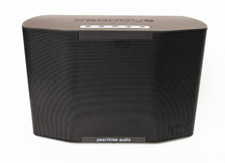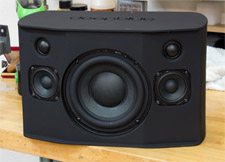It’s the time of year for saving money!
A lot of audio writers won’t even deal with wireless speakers. Show them a Sonos, an AirPlay speaker or a Bluetooth speaker and their minds are closed. They should be, because most of these speakers are designed with style and price point (and maybe maximum volume) in mind. A couple of weeks ago, though, I reviewed one of the very small number of wireless speakers that sounds really good. And if you dig into the way it’s designed, it’s no wonder it sounds good.
 The speaker is the Peachtree Audio deepblue2, which I reviewed for About.com Stereos. I think I’ve tested every one of the deepblue2’s competitors, and to me it’s an obvious standout — and probably the one large Bluetooth speaker I’ve tested where I can’t find a single thing I don’t like about it, or a single thing I’d change about it. It’s $499, so Peachtree was able to spend enough money on the design, parts and manufacturing to get it right. But still, it even beats out more-expensive models. It’s so good I’d recommend it to audiophiles for rooms where they want good sound but don’t necessarily need or want a full stereo system.
The speaker is the Peachtree Audio deepblue2, which I reviewed for About.com Stereos. I think I’ve tested every one of the deepblue2’s competitors, and to me it’s an obvious standout — and probably the one large Bluetooth speaker I’ve tested where I can’t find a single thing I don’t like about it, or a single thing I’d change about it. It’s $499, so Peachtree was able to spend enough money on the design, parts and manufacturing to get it right. But still, it even beats out more-expensive models. It’s so good I’d recommend it to audiophiles for rooms where they want good sound but don’t necessarily need or want a full stereo system.
The key to the deepblue2’s sound quality is that it’s designed like a good 2.1-channel desktop stereo system, all built into a single box. A single, high-excursion 6.5-inch woofer serves as the sub. Flanking it are two-way minispeakers, each with a 3-inch midrange/woofer below a 1-inch tweeter — the same vertical orientation as in a conventional speaker, which delivers broad horizontal dispersion and fairly consistent sound quality all across a room. The deepblue2 also packs amps rated at a total of 440 watts, which is a lot of power for a wireless speaker.
Compare this with a typical wireless speaker, even a higher-end model. Many use full-range drivers — usually a cone driver 2 to 3 inches across — to cover most of the audio range, with either a woofer or a passive radiator to help out with the bass. The problem with full-range drivers is that their response above about 6 or 8 kHz is usually very ragged, and their dispersion at high frequencies is poor. Thus you get that boxy, confined sound for which one-piece wireless systems are so often criticized.
 Some better models use two high-quality tweeters with a woofer; examples include the Marshall Stanmore and the MartinLogan Crescendo. Both sound very nice from a tonal standpoint, but because both of them reproduce all of the bass and midrange with a single midrange/woofer, they have a very monophonic sound.
Some better models use two high-quality tweeters with a woofer; examples include the Marshall Stanmore and the MartinLogan Crescendo. Both sound very nice from a tonal standpoint, but because both of them reproduce all of the bass and midrange with a single midrange/woofer, they have a very monophonic sound.
The deepblue2 isn’t the only wireless speaker built like a conventional speaker. Another example is the Sonos Play:1. In my opinion, it’s the best-sounding speaker Sonos makes; so, too, says this outstanding speaker reviewer. The reason why the Play:1 is so good is that it incorporates a single 3.5-inch midrange/woofer and a single 1-inch tweeter. Obviously it can’t play in stereo, but from a tonal accuracy standpoint it’s the equal of many of the best affordable conventional minispeakers.
Single-box wireless audio systems don’t have to suck. Just build them like real audio systems. They still won’t do stereo like two separate speakers can, but they can do everything else just as well — and thanks to their internal amps and digital signal processing, they can do a lot of things better.





